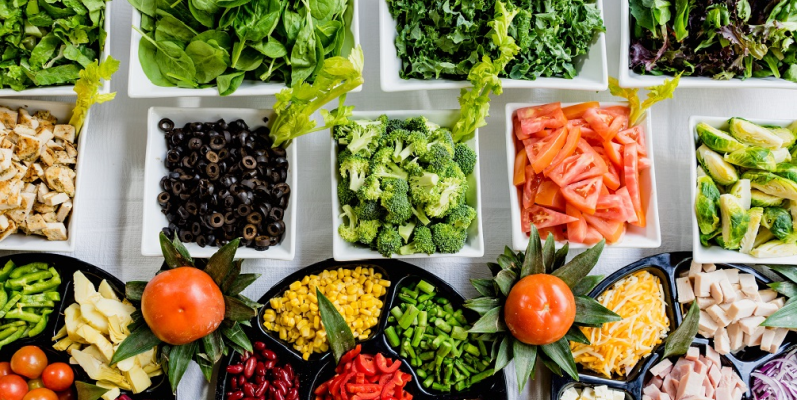Lettuce, Kale and Spinach: The Nutritional Showdown
Whether the topic is yogurt, fruit, crackers or greens, a common question among our clients is, “What is the best option?” Given that there are such a large variety of items at the grocery store, this is a completely valid question. When it comes to green-leafy vegetables like kale, lettuce and spinach, there may be differences in what they provide and when they are best to use, and we will compare them here. However, that being said, the key message to take away is that including any green-leafy vegetables in your routine is better than none!
Just Romaine Around
Nutritional Value: When we compare the nutrients that each leafy green provides, romaine lettuce comes out as the weakest link from a nutrient standpoint (see table below).
In the Kitchen: Romaine works best raw in salads or used in place of a taco shell, tortilla or wrap if the leaf is big enough. It pairs well with Mexican-inspired dishes! The taste of romaine is very mild.
In the Grocery Store: Romaine can only be purchased fresh, and that’s a good thing! Frozen romaine doesn’t sound too appetizing.
Cost: Romaine comes out at about $1.97 per bunch and $3.88 per bag.
Had a Good Spinach the Amusement Park
Nutritional Value: Spinach comes out in the middle from a nutritional standpoint.
In the Kitchen: Spinach is the most versatile in the kitchen! It works as a great base for salads, but also works well in sauces, soups and stews as it wilts down. It can also be used in dips, and blends really well into smoothies (Brandon built a resource for My Viva Plan on how to build smoothies that our team loves to use with clients 😁.) Be careful not to overcook when including it in hot dishes, as the taste will change! The flavour is more intense than romaine, especially when cooked.
In the Grocery Store: You can find spinach in both the frozen, fresh and canned sections of the grocery store. Stick with frozen or fresh depending on what you are using it for. Be mindful that canned spinach will most likely have more sodium and won’t taste as good.
Cost: Fresh spinach works out to about $1.97 per bunch and $2.97 per bag. Frozen spinach is about $2.77 per block.
About to Kale This Workout
Nutritional Value: Kale comes out the strongest when it comes to nutrients available per serving. Keep in mind that it also has the strongest flavour and most interesting texture!
In the Kitchen: Kale is a cruciferous vegetable like cauliflower, broccoli and cabbage—that’s where that strong taste comes from! Some individuals have good gut tolerance of these foods, while others do not. If you can tolerate kale, it can be quite versatile in the kitchen (think salads, kale chips and hot dishes). That being said, it needs a little extra love to calm down its rough texture. With all that fibrous texture, it doesn’t work the best in smoothies. Opt for spinach or baby kale instead.
In the Grocery Store: Just like spinach, you can find kale fresh, frozen or canned. Go with fresh or frozen, depending on what you are using it for. Fresh is best for things like salads or kale chips, but frozen could be used in soups, stews or hot dishes like lasagna!
Cost: Fresh kale comes out to about $1.98 per bunch and goes up to $4.48 per bag. Stick with bunches—just makes sure you wash it well, as dirt tends to get stuck in all that ruffage. Frozen kale is about $3 per block.
(Side note: if you have difficulty tolerating kale and want to learn how to incorporate it into your diet, Laura can help!)
Here’s the nutrient breakdown for each:
| Calcium (mg) | Iron (mg) | Magnesium (mg) | Potassium (mg) | Vitamin A (µg) | Vitamin C (mg) | Vitamin K (µg) | Folate (µg) | |
|---|---|---|---|---|---|---|---|---|
| Romaine | 33 | 0.97 | 14 | 247 | 436 | 4 | 103 | 136 |
| Spinach | 99 | 2.71 | 79 | 558 | 469 | 28 | 483 | 194 |
| Kale | 150 | 1.47 | 47 | 491 | 500 | 120 | 705 | 141 |
*Amount of nutrients per 100 g portion.
Conclusion
Even though kale comes out on top with the highest delivery of nutrients, don’t forget that any green-leafy vegetable is better than none! The cost difference is minor, so choose your go-to greens based on your individual preference, taste and tolerance. It isn’t worth eating it if it isn’t enjoyable, so get creative and figure out which greens you like best! If you need support with this, our chefs offer 1-on-1, couples, and family cooking sessions.
Go greens!
Want to eat more greens and don’t know where to start? Chat with one of our dietitians to learn about how we can help!

